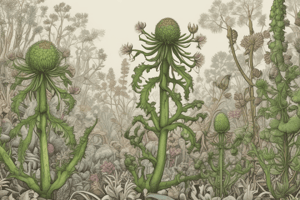Podcast
Questions and Answers
What is the predominant stage of the life cycle of a moss?
What is the predominant stage of the life cycle of a moss?
- Protonema stage
- Sporophyte stage
- Fragmentation stage
- Gametophyte stage (correct)
Which structures produce the male and female gametes in mosses?
Which structures produce the male and female gametes in mosses?
- Capsules and spores
- Antheridia and archegonia (correct)
- Roots and leaves
- Protonema and rhizoids
What distinguishes the sporophyte of mosses from those of liverworts?
What distinguishes the sporophyte of mosses from those of liverworts?
- Its size and shape
- Its elaborate structure (correct)
- The presence of chlorophyll
- The absence of a capsule
What type of leaves do pteridophytes like Selaginella possess?
What type of leaves do pteridophytes like Selaginella possess?
What primarily differentiates pteridophytes from bryophytes in their life cycle?
What primarily differentiates pteridophytes from bryophytes in their life cycle?
What is the primary function of the sporophylls in sporophytes?
What is the primary function of the sporophylls in sporophytes?
Which type of plant produces two kinds of spores, macro and micro spores?
Which type of plant produces two kinds of spores, macro and micro spores?
What adaptation do the leaves of gymnosperms like conifers have to withstand harsh environmental conditions?
What adaptation do the leaves of gymnosperms like conifers have to withstand harsh environmental conditions?
What structure is formed after the fusion of the male gamete with the egg in gymnosperms?
What structure is formed after the fusion of the male gamete with the egg in gymnosperms?
What distinct feature characterizes gymnosperms in terms of their seeds?
What distinct feature characterizes gymnosperms in terms of their seeds?
Flashcards are hidden until you start studying
Study Notes
Mosses
- The gametophyte is the dominant stage in the moss life cycle, consisting of two phases: protonema and leafy stage.
- Protonema, originating from spores, is creeping, green, and branched, often filamentous.
- The leafy stage features upright axes with spirally arranged leaves, anchored to soil via branched rhizoids.
- This stage bears sex organs; vegetative reproduction occurs through fragmentation and budding.
- Sexual reproduction involves antheridia (male) and archegonia (female) at the apex of leafy shoots.
- After fertilization, the zygote develops into a sporophyte, comprising a foot, seta, and capsule.
- Sporophytes are more elaborate in mosses compared to liverworts, with capsules that contain spores formed by meiosis.
- Mosses possess an intricate spore dispersal mechanism.
- Common moss examples include Funaria, Polytrichum, and Sphagnum.
Pteridophytes
- Includes horsetails and ferns, used for medicinal purposes, soil-binding, and ornamental growth.
- First terrestrial plants with vascular tissues (xylem and phloem).
- Typically thrive in cool, damp, shady locations; some may grow in sandy soils.
- Dominant life cycle phase is the sporophyte, differentiated into true roots, stems, and leaves.
- Leaves can be microphylls (small, as in Selaginella) or macrophylls (large, as in ferns).
- Sporophytes bear sporangia supported by sporophylls, which can form strobili or cones.
- Spores are produced via meiosis, germinating into small, photosynthetic gametophytes called prothallus.
- Gametophytes grow in moist environments, requiring water for fertilization; they bear antheridia and archegonia.
- Male gametes (antherozoids) require water for transport, leading to zygote formation within archegonia.
- Most pteridophytes are homosporous; genera like Selaginella and Salvinia are heterosporous, producing both macro and micro spores.
- Development of zygotes within female gametophytes is a step towards seed evolution.
- Classifications: Psilopsida (Psilotum), Lycopsida (Selaginella, Lycopodium), Sphenopsida (Equisetum), and Pteropsida (Dryopteris, Pteris, Adiantum).
Gymnosperms
- Gymnosperms (means "naked seeds") have ovules that are not enclosed by an ovary wall before and after fertilization.
- Seeds remain exposed post-fertilization; include medium to tall trees and shrubs.
- The giant redwood tree, Sequoia, is among the tallest tree species.
- Roots typically form tap roots; some have mycorrhizal associations, while others like Cycas possess coralloid roots that associate with N2-fixing cyanobacteria.
- Stems can be unbranched (Cycas) or branched (Pinus, Cedrus).
- Leaves in gymnosperms can be simple or compound; Cycas has long-lasting pinnate leaves.
- Adapted for harsh conditions: conifers have needle-like leaves that reduce surface area and exhibit thick cuticles and sunken stomata to withstand extreme temperatures and humidity.
Studying That Suits You
Use AI to generate personalized quizzes and flashcards to suit your learning preferences.




